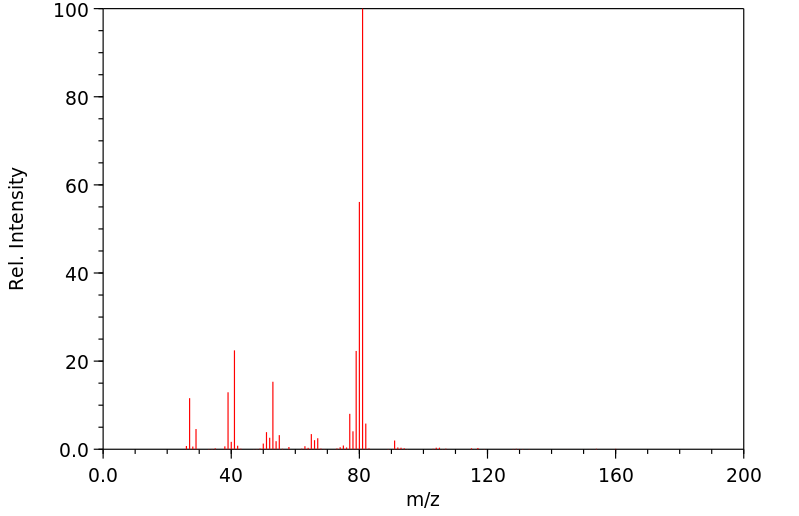3,3'-联[环己烯] | 1541-20-4
中文名称
3,3'-联[环己烯]
中文别名
——
英文名称
bicyclohexyl-2,2'-diene
英文别名
[1,1′-bi(cyclohexane)]-2,2′-diene;[1,1'-bi(cyclohexane)]-2,2'-diene;3,3′-bi(cyclohexene);1,1'-bis(cyclohex-2-ene);3,3'-bicyclohexenyl;3,3'-dicyclohexene;Bi-2-cyclohexen-1-yl;3-cyclohex-2-en-1-ylcyclohexene
CAS
1541-20-4
化学式
C12H18
mdl
——
分子量
162.275
InChiKey
HFROTUORNFZKSE-UHFFFAOYSA-N
BEILSTEIN
——
EINECS
——
-
物化性质
-
计算性质
-
ADMET
-
安全信息
-
SDS
-
制备方法与用途
-
上下游信息
-
文献信息
-
表征谱图
-
同类化合物
-
相关功能分类
-
相关结构分类
物化性质
-
熔点:236.5-237 °C
-
沸点:127 °C(Press: 30 Torr)
-
密度:0.924 g/cm3(Temp: 28 °C)
计算性质
-
辛醇/水分配系数(LogP):4.3
-
重原子数:12
-
可旋转键数:1
-
环数:2.0
-
sp3杂化的碳原子比例:0.67
-
拓扑面积:0
-
氢给体数:0
-
氢受体数:0
安全信息
-
海关编码:2902199090
SDS
反应信息
-
作为反应物:描述:参考文献:名称:Canonica,L. et al., Gazzetta Chimica Italiana, 1967, vol. 97, p. 1370 - 1390摘要:DOI:
-
作为产物:描述:参考文献:名称:ZnIn2S4 上的光催化羰基自由基引发的羰基-Csp2/Csp3 偶联摘要:可以在ZnIn 2 S 4光催化剂上实现羰基自由基引发的分子内环化和分子间交叉偶联反应。通过这种方式,可以生产苯并二氢呋喃和叔醇等工业上重要的化学品。DOI:10.1002/chem.202203785
文献信息
-
Organotitanium chemistry XVIII. Dehalogenation of organic halides by Cp2TiX (X = Cl, Br)作者:Qian Yanlong、Li Guisheng、Yao-Zeng HuangDOI:10.1016/0022-328x(90)85446-6日期:1990.1Dicyclopentadienyltitanium chloride and bromide prepared in situ from the reduction of dicyclopentadienyltitanium dichloride by isopropylmagnesium chloride and bromide, respectively, are effective dehalogenating reagents for benzylic, allylic halides and α-bromoketones. Benzylic and allylic halides are transformed into the coupling products whereas the α-bromoketones are reduced to the corresponding ketones
-
Dimerization of Benzyl and Allyl Halides via Photoredox-Mediated Disproportionation of Organozinc Reagents作者:Alexander Dilman、Vitalij Levin、Daniil Agababyan、Marina StruchkovaDOI:10.1055/s-0036-1591583日期:2018.8Published as part of the Special Topic Modern Radical Methods and their Strategic Applications in Synthesis Abstract Benzyl and allyl halides undergo homocoupling when treated with zinc in the presence of a catalytic amount of a cationic iridium(III) complex under irradiation with 400 nm light-emitting diodes. The reaction proceeds through the intermediate formation of an organozinc reagent, which disproportionates
-
Deoxygenative Dimerization of Benzylic and Allylic Alcohols, and Their Ethers and Esters Using Lanthanum Metal and Chlorotrimethylsilane in the Presence of a Catalytic Amount of Iodine and Copper(I) Iodide作者:Toshiki Nishino、Yutaka Nishiyama、Noboru SonodaDOI:10.1246/bcsj.76.635日期:2003.3Benzylic and allylic alcohols were deoxygenatively dimerized by a treatment with lanthanum metal and chlorotrimethylsilane in the presence of a catalytic amount of iodine, giving the corresponding coupling products, alkanes, in moderate-to-good yields. This dimerization reaction was dramatically accelerated by the addition of a catalytic amount of copper(I) iodide. Similarly, ethers and esters were
-
Novel Reactivity of N-Bridged Diiron Phthalocyanine in the Activation of CH Bonds: Hydroacylation of Olefins as an Example of the Efficient Formation of CC Bonds作者:Leonardo X. Alvarez、Evgeny V. Kudrik、Alexander B. SorokinDOI:10.1002/chem.201100650日期:2011.8.16Bridge over troubled iron: An N‐bridged diiron tetra‐tert‐butylphthalocyanine complex, usually employed for oxidation reactions, also catalyzes the addition of acetaldehyde to olefins (see scheme) to provide methylketones with a high selectivity (up to 92 %) and high turnover numbers (3600–5700).
-
Light-mediated transformations of olefins into alcohols: reactions of hydroxyl radicals with cycloalkenes作者:H.R. Sonawane、B.S. Nanjundiah、R.G. KelkarDOI:10.1016/s0040-4020(01)82107-4日期:1986.1Reactions of hydroxyl radicals, generated by photodecomposition of hydrogen peroxide in acetonitrile, with a wide variety of cycloalkenes have been examined. The results show that the major reaction is the addition of hydroxyl radicals to the less substituted end of the double bond, furnishing the secondary alcohols. The reactivity pattern and the observed regio- and stereoselectivity clearly reveal
表征谱图
-
氢谱1HNMR
-
质谱MS
-
碳谱13CNMR
-
红外IR
-
拉曼Raman
-
峰位数据
-
峰位匹配
-
表征信息
同类化合物
高密聚乙烯
香叶醇
顺式3-甲基-2-己烯
顺式-5-癸烯
顺式-5-甲基-2-己烯
顺式-5-庚烯-1-炔
顺式-4-癸烷
顺式-4-甲基-2-戊烯
顺式-4-甲基-2-戊烯
顺式-3-癸烯
顺式-3-甲基-3-己烯
顺式-3-甲基-2-庚烯
顺式-3-戊烯-1-炔
顺式-3,4-二甲基-3-己烯
顺式-3,4-二甲基-2-戊烯
顺式-3,4-二甲基-2-戊烯
顺式-2-甲基-3-己烯
顺式-2-壬烯
顺式-2-丁烯-D1
顺式-1.1.1-三甲基-2-丁烯
顺式-1-甲基-2-环丙基乙烯
顺式-1-甲基-2-乙烯基环戊烷
顺式-1-环戊基-1-辛烯
顺式-1-氘代-3-甲基-1-丁烯
顺式-(9ci)-2,3,3a,7a-四氢-4-(1-甲基乙基)-1H-茚
顺式-(2-丁烯基)环丙烷
顺式,顺式-2,4-己二烯
顺-环辛烯
顺-9-二十一碳烯
顺-6-十三碳烯
顺-5-甲基-1,3,6-庚三烯
顺-4-辛烯
顺-4-壬烯
顺-3-辛烯
顺-3-甲基-2-戊烯
顺-3-壬烯
顺-3-十三碳烯
顺-2-辛烯
顺-2-癸烯
顺-2-戊烯
顺-2-庚烯
顺-2-己烯
顺-2-丁烯
顺-2,2-二甲基-3-己烯
顺-1,3-戊二烯
顺,顺-1,9-环十六烷二烯
顺,顺,顺-环癸-1,3,5-三烯
间戊二烯
间二(4-吡啶基)苯
镁,二-2-丁烯基-







